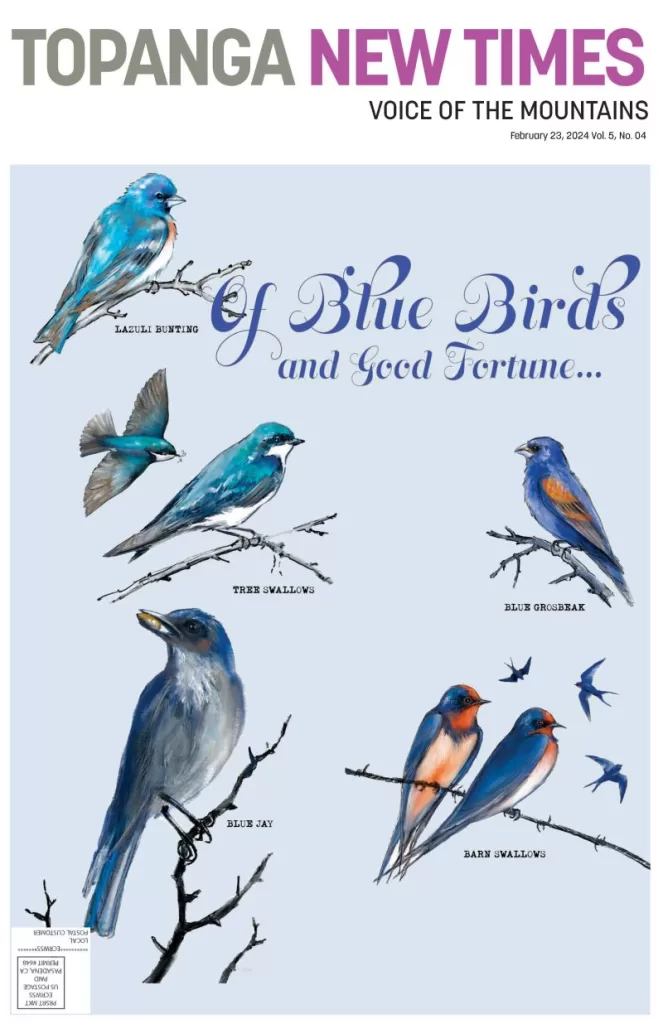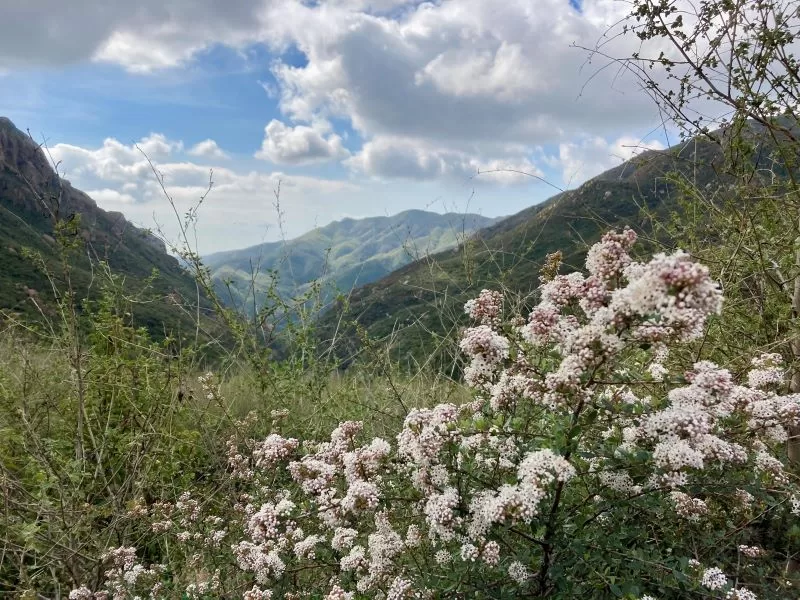
Feeling blue? Blue-colored birds are traditional symbols of heaven and good fortune in many cultures around the world. At this time of year in the Santa Monica Mountains, one need look no further than our own backyard to find the mythical bluebird of happiness. From the California scrub jay to the Western bluebird, we have the story in our Discover section. Watercolor illustrations by Suzanne Guldimann. Cover concept and design by Urs Baur.
The rain makes still pools on the sidewalk
The rain makes running pools in the gutter
The rain plays a little sleep song on our roof at night
And I love the rain.
—Langston Hughes, “April Rain Song”
Langston Hughes’ poem reminds us to take a moment to reflect on the rain, to experience it as a blessing. That can be a challenge when the rain comes all at once, channeled into monotonous excess by the atmospheric river, but even at its most destructive, rain here is a blessing. It brings the promise of new life and growth. It fills and recharges creeks and springs, providing insurance against dry years. It washes away the dust of the dry season and replaces it with the promise of renewal, no matter how temporary. Here in the Santa Monica Mountains the ceanothus is in bloom, a tide of small white flowers that are fueled by the rain and that cover the hills like a dust of snow.
The ceanothus is one of Topanga’s first harbingers of spring, but nesting and breeding season is already underway throughout the mountains.

The great horned owls in the neighbor’s eucalyptus tree are incubating eggs. I hear their soft conversation in the early hours of the morning, complaining, perhaps, about the rain. House finches, bluebirds and oak titmice are scouting for nest holes, the frogs are singing by the creek, and many species of wildlife, including skunks, are abroad looking for love. Vehicle strikes take a terrible toll. It’s especially important to slow down and stay alert on the road this time of year.
Wildlife in the road isn’t the only hazard this season: rocks, mud, downed trees and branches, and flooding continue to make driving on canyon roads hazardous and unpredictable.
As we mop up from the most recent round of rainstorms it is important to remember that it takes time for the land to absorb the water, which means rock and mudslides can occur days, or even weeks after the rains have ended. And all that rain means a bumper crop of potholes and broken pavement. A flat tire, busted shock absorber, or broken axle is expensive as well as inconvenient—take it from one who knows. Be careful out there!
Presidents’ Day fell on February 19 this year. That date marks another, darker, aspect of American history. On February 19, 1942, US President Franklin D. Roosevelt signed Executive Order 9066, forcing 120,000 Japanese Americans into concentration camps. It doesn’t receive much press, but this Day of Remembrance is important as a reminder of how fear and paranoia empowered the unscrupulous to deprive US citizens of their constitutional rights. It is important to remember, and to ensure that no American citizens are ever again imprisoned or detained based on race, or for their religion, nationality, sex, gender identity, sexual orientation, ethnicity or disability.
Topanga is getting ready for the return of its farmers market, on March 1, at the Topanga Community Center. We have all the details on the new market, and the women who are working hard to make it a reality. Also in this issue, TNT contributor Claire Fordham sits down with Topanga Home Grown boutique’s Jane Hoover for the story of her life; TNT historian Jimmy P. Morgan shares his thoughts on a thought-provoking book by Hanif Abdurraqib: A Little Devil in America: Notes in Praise of Black Performance; we take a look at bluebirds and birds that are blue, and share some ideas for how to re-wild our gardens this spring; and life coach and Work + Life Balance columnist Olivia Pool reflects on why boring isn’t bad—although there is nothing boring about this issue of TNT! Thank you for reading!
Stay safe, be well!













